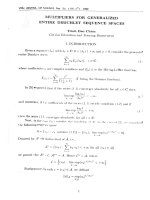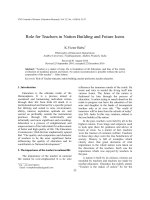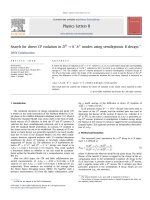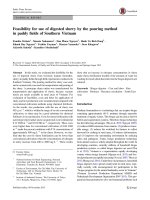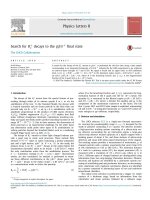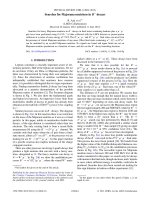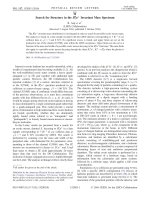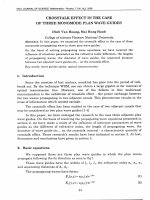DSpace at VNU: Internationalization for ASEAN University: Case Study of CMU-ULL
Bạn đang xem bản rút gọn của tài liệu. Xem và tải ngay bản đầy đủ của tài liệu tại đây (659.86 KB, 7 trang )
VNU Journal of Science, Vol. 31, No. 4 (2015) 30-36
Internationalization for ASEAN University:
Case Study of CMU-ULL
N. Chakpitak1, A. Bouras2
1
International College, Chiang Mai University, Thailand
2
College of Engineering, Qatar University
Received 10 March 2015
Accepted 20 December 2015
Abstract: Today internationalization for universities means “Mobility”. In ASEAN Community,
mobility of students is a requirement for 30 leading universities in ASEAN University Network.
This prepares new generation of university graduates for skilled labor mobility in ASEAN. The
mobility aims at enrichment by home university rather than academic contents which is now
available publicly on Internet. AUN members are working as equal partners to developsome
educational practices for internationalization among ASEAN countries. These practices can be
generalized for mobility of ASEAN students to Europe, America and other regions in the future.
Lessons Learned from European Community in credit transfer system, quality assurance system
and common framework are essential for ASEAN universities to faster develope their suitable own
systems. Erasmus Mundus projects help many universities in ASEAN region to mobilize their
students to Europe in the past 10 years.Chiang Mai University with Lyon2 University has
experienced in European Credit Tranfer System, Quality Management System, Common European
Framework and Cooperative Education. The integrated international academic and research affairs
framework is proposed for cost effective and sustainable development.
1. Introduction∗
Social-Culture are addressed. ASEAN aims at
becomingsingle market and single production
base finally. To achive the goals, ASEAN has
strategic intent to implement free flows of
goods, services, investment, capital and skilled
labors among member countries. Thus an
individual member country can develop a
competitive industry on their own strenght such
as raw material and unskilled labor by sharing
resources including finanical captial and skilled
labor from other member contries. At the same
time, the other countries is also a market for the
industry. By this way, the developed ones can
help the developing ones. The gap among
members can be reduced significantly.
The Association of Southeast Asian Nations
(ASEAN) [1] was established in 1967. The
member countries of the association are Brunei
Darussalam, Cambodia, Indonesia, Lao PDR,
Malaysia, Myanmar, Philippines, Singapore,
Thailand and Viet Nam. ASEAN countries have
a firmed plan to join together for having One
Vision, One Identity and One Community by
the end of 2015. To create unity among
partners, Political-Security, Economic and
_______
1
2
Email:
Email:
30
N. Chakpitak, A. Bouras / VNU Journal of Science, Vol. 31, No. 4 (2015) 30-36
The free flow of skilled labor directly
supports the free flow of services by 2015.
ASEAN is also working towards harmonisation
and standardisation, with a view to facilitate
their movement within the region.In actions,
the cooperation among ASEAN University
Network (AUN) members areenhanced to
increase mobility for both students and staff
within the region. Furthermore, core
competencies and qualifications are specified
for job/occupational and trainers skills required
in the priority services sectors by 2009 and in
other services sectors from 2010 to 2015. The
research capabilities of each ASEAN member
country are strengthen in terms of promoting
skills, job placements, and developing labour
market information networks among ASEAN
member countries.
In Europe, European Credit Transfer
System (ECTS) has been promoted among
European Community since 2000. In Erasmus
Mundus Action 2 programme, mobility grants
at undergraudate, master and doctoral levels has
been given to other regions for more than 10
years. This promoted credit transfer with
European universitie by using ECTS.
2. Current context of asean developments
In 1992, the 4th ASEAN summit had the
call for cooperation in the field of higher
education and human resource development.
Later on the charter of the ASEAN University
Network (AUN) [2] was signed by the ASEAN
ministers in order to be responsible for higher
education in 1995. In concurrent, the agreement
on the establishment of AUN was signed by
presidents, rectors and vice chancellors of
participating universities. In 2008, one of the
ASEAN sectorial ministerial body is
responsible for higher education cooperation
and development. The AUN has mandates in:
1. Strengthen the existing network of
cooperation among universities in ASEAN and
beyond;
31
2. Promote collaborative study, research
and educational programs in the priority areas
identified by ASEAN;
3. Promote cooperation and solidarity
among scholars, academicians and researchers
in the ASEAN Member States;
4. Serve as the policy-oriented body in
higher education in the ASEAN region.
Till now, there are 30 universities from 30
AUN members. The collaboration mainly
consists of internationalization for academic
quality improvement,
higher
education
harmonization and ASEAN awareness through
mobility. These collaboration leads to some
research collaboration. The 9 AUN research
thematic subnetworks have been established as
follows: AUN-Quality Assurance, AUN Human
Rights, AUN Intellectual Property, AUN
Business and Economics Network, AUN Interlibrary Online, AUN University Social
Responsibility & Sustainable, AUN Southeast
Asia Engineering Education Development
Network, AUN Credit Transfer System and
AUN Health Promotion Network. The 4
networks including AUN Southeast Asia
Engineering Education Development Network,
AUN Business and Economics Network, AUN
University Social Responsibility & Sustainable
and AUN Human Rights also focus on research
collaboration in ASEAN.
The development of AUN-QA had
technical assistance from European at initial
stage. Recently more than 140 programs in
ASEAN universities have had AUN-QA
assessment. Besides quality assurance, AUNACTS provides mobility among AUN partners.
On the basic operation, each member annually
grants 5 outbound full-time scholarships for one
semester to another host universities in different
countries in ASEAN. In mobility, students
should have credit transfer from the host
university. The AUN partners learn to
harmonize students’ host and home educational
systems.
AUN has started with Quality Assurance
and promoting of its benefits of QA. Then
32
N. Chakpitak, A. Bouras/ VNU Journal of Science, Vol. 31, No. 4 (2015) 30-36
different credit systems are recognized among
member countries for doing student mobility,
which leads to the ultimate goal in worker
mobility. This can harmonize professional
qualification among ASEAN countries.
Beyond AUN-QA and AUN-ACTS, AUN
plans to implement ASEAN Quality Reference
Framework in the near future. This directly
leads to the harmonization of professional
qualifications. Since Thailand has initiated
Thailand Qualification Framework (TQF) for
professional requirement, curriculum, teaching
plan, laboratory plan, teaching evaluation,
laboratory
evaluation
and
curriculum
evaluation. All universities in Thailand have
been enforced to be under the qualification
framework since 2014. A university curriculum
should
meet
a
specific
profession’s
requirements in various industries such as
medicine, engineering, accounting, law, etc.
AUN-QA, ACTS and AQRF can facilitate
ASEAN universities to ensure quality
education, promote students mobility and
enhance professional or workforce mobility.
Figure 1. AUN Systems (N. Gajaseni, 2015).
Usually it is difficult to encourage ASEAN
students to have mobility in ASEAN. They
would like to have mobility to Europe or
America rather than ASEAN. Besides
Singapore, Malaysia and Philippine, English
skill is the main barrier for most university
students in other countries on mobility.
Actually not only students but also lecturers
have no incentive to have mobility. Therefore
department-to-department collaboration should
cover all their international programs, postgraduate research and projects activities at
international recognition. The essential
incentives should include financial, business
facility, research seed fund, flexibility, etc.
ACTS has “Student First” operational
concept. It aims at 3Es: Enrichment purpose,
Enhancement of student’s soft skills and
Exposure of international experience to
students. The students should benefit credit
earning, intellectual exchange and networking
of ASEAN friends. The AUN members are
working together based on “Quality Assurance”
and Trust “Building” principle.
At research collaboration, it is found that
Singapore and Malaysia universities perform
very well at university ranking. But they
internationally collaborate with famous
universities in USA, Australia, England,
France, Germany, China, Japan and South
Korea rather than ASEAN countries. Table 1 is
shown obviously the co-authorship of ASEAN
members with others. Since Thailand has
borders with Myanmar, Laos and Cambodia
therefore many research works have been done
together. There are many post-graduate
scholarships granted to neighboring countries
for coming to study in Thailand.
N. Chakpitak, A. Bouras / VNU Journal of Science, Vol. 31, No. 4 (2015) 30-36
33
Figure 2. ASEAN Credit Transfer System Principle (N. Gajaseni, 2015)
Table 1. Rank Order of International Collaboration for Each ASEAN Member Nation, 2011-2014 (Thomson
Reuters, 2015)
3.
Lessons
collaborations
learned
from
EMA2
The academic and research collaboration
between Institute for University Technology
(IUT), Lyon2 university and College of Arts,
Media and Technology (CAMT), Chiang Mai
University has been sustainably developed by
supports from Europe in the past 10 years.
Since 2005, the Asia Link EAST-WEST project
assisted the College of Arts, Media and
Technology, Chiang Mai University in
establishment including staff development,
academic development, joint doctoral program
34
N. Chakpitak, A. Bouras/ VNU Journal of Science, Vol. 31, No. 4 (2015) 30-36
and Ph.D. research procedure. In 2009, the
Thailand-EC ETHICS project helped in setting
up cooperative education system with
international industrial estate. Moreover the
Thailand-EC SQUARE project implemented
ISO9000 Quality Management System and
piloted on undergraduate, master and Ph.D.
Programs. In addition, the Franco-Thai
Sustainable e-Tourism project provided visiting
professor and research student exchange for fact
finding on common research interests and
opportunities in both sides.
Since 2009 till now, Erasmus Mundus
Action 2 eLINK, Sustainable e-Tourism,
cLINK, FUSSION and SmartLINK projects
have provided mobility of students and staffs.
The mobility includes undergraduate, postgraduate, doctoral, post-doctoral and staff.
Furthermore, Software, Knowledge and
Information Management and Applications
(SKIMA) conference has been organized
annually since 2006. The conference opens
opportunity for meeting on research among
master, doctoral, post-doctoral and professors
from all who study in host or home institutes.
This allows that the staffs and students who are
not in mobility projects can participate.
Furthermore,
Common
European
Framework
Reference
(CEFR)
has
experimented with British Council, Chiangmai
on 14 courses modularly delivered by visiting
professors of the international program in
software engineering. English skill practice in
reading, listening, speaking and writing has
been integrated into the computer science study
program. This provides an efficient way to
prepare students for mobility.
Mean while running the European projects
above, Chiang Mai University has followed the
national policy conducted by Commission for
Higher Education in implementation of national
frameworks including quality assurance, credit
transfer system, qualification framework,
English and IT literacy, work integrated
learning and entrepreneurship. It provides
readiness of Thai universities for joining
ASEAN community by the end of 2015.
The learned lessons from the European
projects and the Thai frameworks can be
illustrated in Table 2.
Table 2. Higher Education Systems by Comparison
4. Next steps forward
On World university ranking such as QS
ranking, the academic indicators are academic
reputation, employer reputation, faculty student
ratio, paper per faculty and citations per paper
for measurement of academic performance. In
addition
on
internationalization,
internationalization indicators including number
of international staff, number of international
N. Chakpitak, A. Bouras / VNU Journal of Science, Vol. 31, No. 4 (2015) 30-36
students, in-bound and out-bound students are
accounted. Foreign professors and students who
come over for more than 3 months can be
counted as international faculties and students.
For student exchange, it requires one semester
study under an universities agreement.
Thus the proposition for ASEAN
universities is new integrated solution of
International Academic and Research Affairs as
shown in Figure 3.In traditional way, university
international affairs office is responsible for
doing Memorandum of Understanding with
foreign universities as well as scholarships from
external for staffs and students. Next
departments
or
faculties
would
do
Memorandum of Agreement for student
exchange projects in terms of credit transfer and
cost sharing. There is less incentive for
professors to participate. Then most student
exchange projects normally are not sustainable.
It can be no further well-developed into jointdegree and research collaboration at senior
project, master and Ph.D. thesis levels as well
as co-research projects.
To sustain the internationalization process,
it needs to directly allocate some budgets with
regard to the ranking indicators for examples,
visiting professors, exchange students and a
35
number of joint-publication. It is necessary for
developing some regular academic and research
collaboration activities with lead universities in
ASEAN and other regions. The alliance builds
up a great potential for acquiring national and
international funding. The ultimate goal for any
leading university is usually to generate a large
number of Ph.D. students and their high quality
publications, which require tremendous
resources. Today, a university can accomplish
in academic quality and financial supports only
with strong international academic and research
networking.
In case of Chiang Mai University,
internationalization budget has been allocated
by the university for international academic and
research affairs with AUN partners as well as
ASEAN+3. Internal funding in terms of
scholarships and seed projects is raised from the
research office and the graduate school.
National grants are acquired from TICA,
National Research Council of Thailand and
other research agencies as well as industry
companies. In addition, international resources
can be acquired from international communities
such as EU, Japan, China, South Korea,
Australia, France, UK, Germany, US, etc.
Figure 3. Road to World-Class University in Internationalization
36
N. Chakpitak, A. Bouras/ VNU Journal of Science, Vol. 31, No. 4 (2015) 30-36
5. Conclusion
International academic and research affairs
are useful for leading universities to develop
network with local and international strategic
partners in internationalization. The budget for
internationalization should be allocated enough
to make ranking indicators and maintain
relationship
with
leading
universities
particularly in visiting professor, student
exchange and research. For mobility of staff,
students and professionals, quality assurance,
credit transfer, qualification, work integrated
learning and entrepreneurship development
systems at higher education can help ASEAN
community for harmonization of education
system and skilled workforce in the future. This
requires enough academic and financial
incentives for students, researchers, professors,
academic departments as well as strengthening
their international programs by efficient
mobility in all undergraduate, master, doctoral,
post-doctoral and staff exchange programs.
References
[1] Roadmap for an ASEAN Community 2009-2015
Jakarta: ASEAN Secretariat, April 2009, ISBN
978-602-8411-04-2.
[2] N. Gajaseni, “ASEAN University network (AUN)
for enhancing internationalization profiles of Thai
universities”, ASEAN University Network, 6 July
2015, Chiang Mai University.
